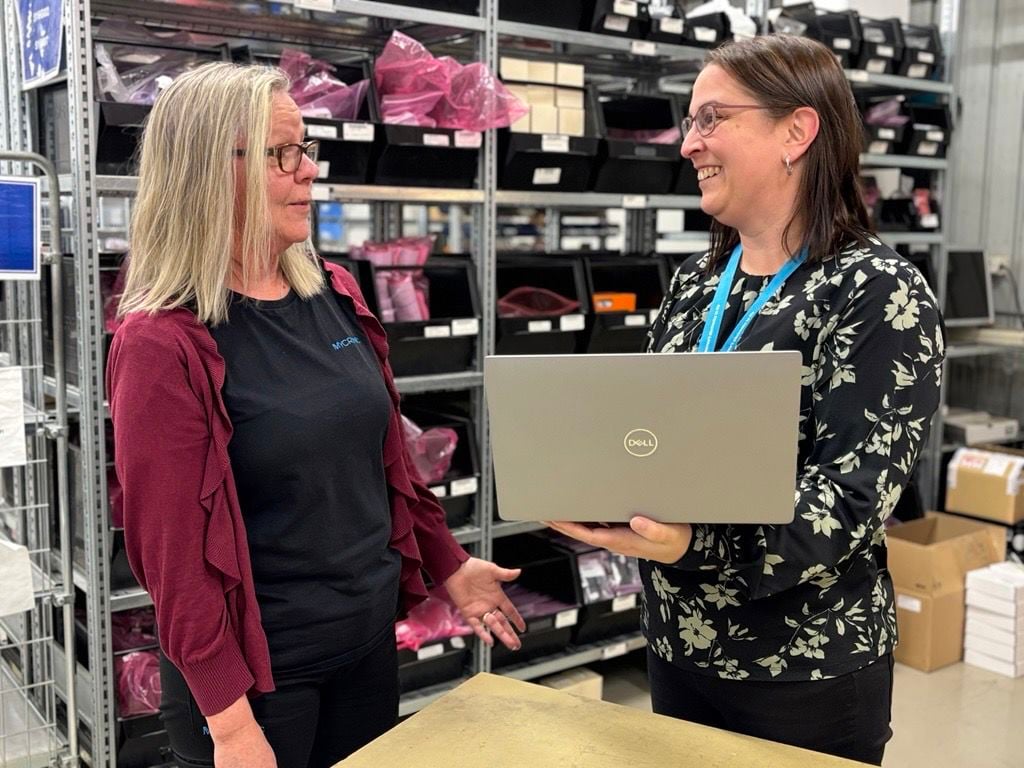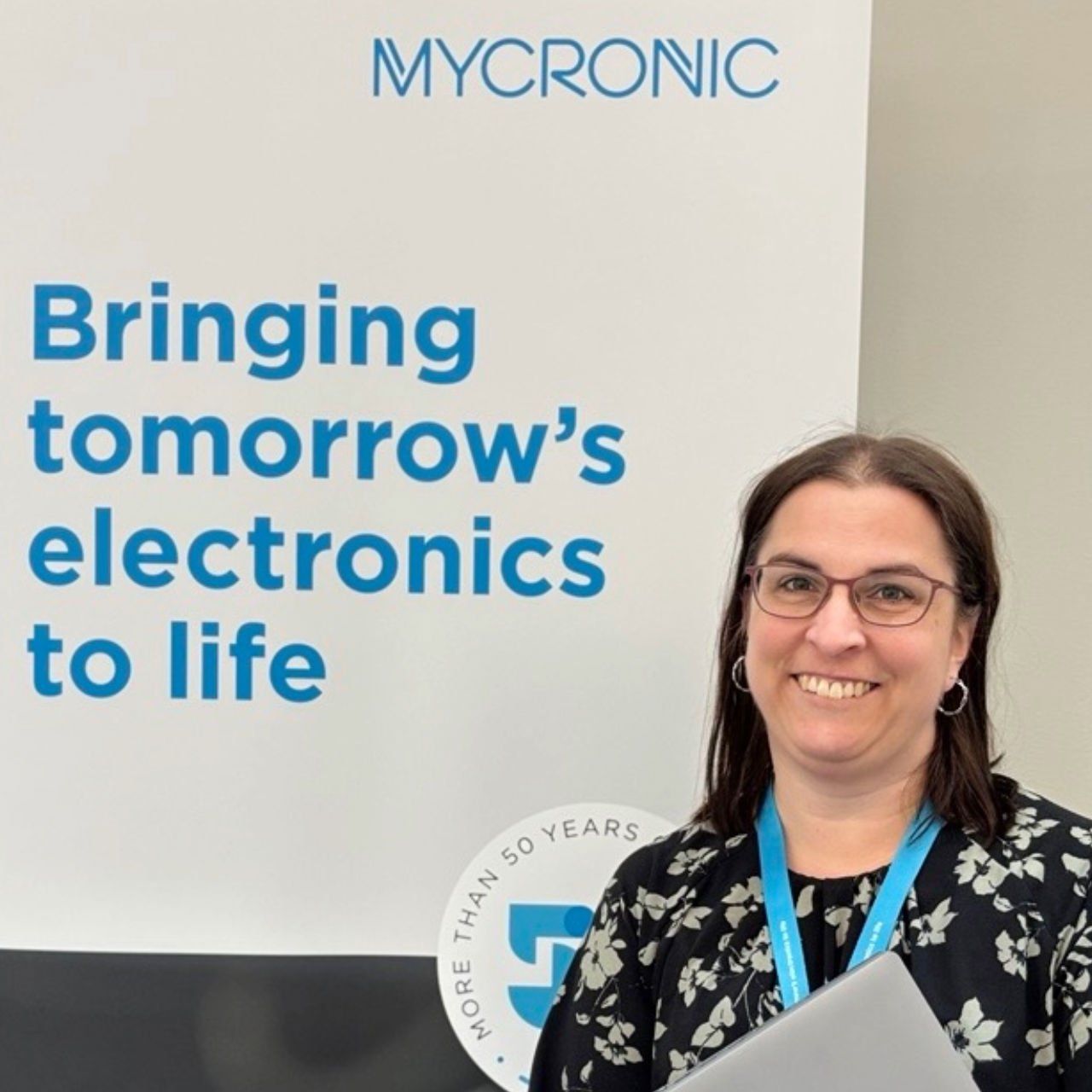Behind the scenes: SMT logistics in action
Step behind the scenes and meet our dedicated experts keeping our customers’ machines running at peak performance. In this exclusive interview series, we sit down with the people driving service success in SMT logistics. Hear firsthand how their passion, precision, and hands-on expertise ensure that every part arrives on time and every customer stays up and running.

Introduction to SMT inventory management
Meet Therese Spångvall, she has been with Mycronic for more than 18 years and is currently working as our Supply Chain Specialist with a focus on outbound processes and inventory management. Steering both HQ warehouse and our multiple subsidiary warehouses ensuring SMT parts are available in more than 50 countries.
Why does SMT maintenance and logistics matter?
Surface Mount Technology (SMT) machines are the heartbeat of efficient PCB assembly with Mycronic customers, ensuring precision, speed, and consistency. But keeping them in peak condition isn’t just about routine check-ups – it’s about how aftermarket processes and logistics are set up to meet customer needs.
Wondering how to can avoid downtime and ensure top-notch quality? If you’re in the midst of consideration to purchase new PCB machines – keep in mind – it’s just as important to partner with a company who has strong proactive maintenance and strategic logistic plans in place for customers. Not just one and done. We embrace the long-term collaborations and partnerships.
Interview starts here:

Therese Spångvall - Supply Chain Specialist, and Tara Kallio - Material Handler, collaborating on part logistics.
Minimizing downtime and maximizing efficiency
Q: Your role involves coordinating shipments, tracking material availability, and ensuring all moving parts come together efficiently. How do you balance working closely with Mycronic offices worldwide while also managing inbound logistics, sourcing, and procurement?
A: It’s pretty much about looking at the wider scope, collecting and connecting everything for it all to work. Then I’ll analyze the levels at our different warehouses to see if we have the correct stock or figure out if there’s any scrapping or pullbacks necessary. I need to consider both sides – inbound and inventories – for the correct levels. This allows us to avoid having too much cost possibly piled up in the warehouses. It comes down to monitoring the big warehouse picture.
Optimizing inventory and change management for seamless SMT operations
Q: Managing Engineering Change Orders (ECOs) seems to be a crucial part of ensuring aftermarket items remain available. How do you integrate new parts into the ERP system?
A: I´m one of the stakeholders who handle ECOs (Engineering Change Orders) when we implement new parts. It’s then put into our ERP system where we make it orderable for the subsidiaries and for HQ, set safety stock levels and other logistics and sales parameters, so it triggers demands or needs when necessary.
Q: When urgent spare parts are needed—like electronic boards for a MY300 machine—how does HQ coordinate with the U.S. warehouse to handle emergencies?
A: Emergencies are primarily managed through the order handling process, which I’m not heavily involved in for customer orders. However, when subsidiaries create a demand and don’t have stock, they escalate an urgent request to HQ. At that point, one of our outbound order handlers at HQ takes over to process the emergency request.
Q:Does Mycronic have any delivery goals for part logistics for customer service?
A: Yes, we always strive to deliver according to customer requests and for urgent demands if the order needs to be delivered as soon as possible. One cornerstone, not just for me, but for everyone within Mycronic, is to get to know our internal and external customers and suppliers. With that knowledge you can better contribute with the information and requirements they need, to make the delivery process flow more seamless.

Strategic inventory management: Optimizing local stock levels for SMT maintenance
Q: How do you determine which articles should always be available in local stock? Is it based on consumption patterns, or do you have set goals for inventory levels in regions like France, the UK, and the US?
A: Yes, the inventory strategy is based on the parts criticality classification, order frequency and cost, ensuring that the most frequently ordered parts are always available in our central supply warehouse but also locally, closer to the customer. We have a stocking model which we recently updated, giving some higher stock levels and more complete assortments at the local offices. This is something we have reviewed in the US and Germany, and then we continue with the other local offices as well. Allowing these locations to have a wider availability.
Scaling global logistics: Managing growth in SMT equipment distribution
Q: With having Mycronic’s portfolio expanding significantly over the past decade. As production has shifted across multiple locations—including Sweden, Japan, France, Germany, and China—can you give us some insight into how Mycronic has found solutions to any challenges that have emerged in streamlining global operations?
A: With manufacturing in Sweden, Japan, and previously in France and Germany, as well as partnerships in China with earlier Axxon and now HCX, we’ve continuously worked to streamline our supply chain processes. Over the years, we’ve adapted to this growth by optimizing our workflows and ensuring our team remains agile. While our focus has primarily been on handling orders, we continue to improve background operations to support seamless logistics.
Q: For full-line customers ordering multiple machines from different regions, how does Mycronic ensure a seamless delivery experience?
A: These orders are managed efficiently by a dedicated team, ensuring a streamlined process from our side. While deliveries may arrive on different days due to global production locations—such as the MY700 from Japan, the MY300 from Sweden, and the HCX stencil printer from China—we continuously work to optimize coordination and improve the overall delivery experience for our customers.
Q: Is sustainability something you keep in mind when you are working on these processes? We talk a lot about sustainability, but how do we really integrate it?
A: We group shipments to avoid multiplying the transport to our subs, which would have a negative impact on our sustainability. And, having the right quantity of goods in the warehouse, we don’t have a lot of things collecting dust for months. Accurate inventory and smart shipping are essential for us. For example, for MY700, which is produced in Japan, our Fukuoka site is our central warehouse for MY700 parts for Asian customers.
Regarding means of transport, we try more and more to ship by boat. For example, for our US subsidiary, we ship several units together by boat, so the carbon impact is lower. Then machines are stored locally which decrease delivery lead time to US customers
Q: Last but not least, what do you like most about your role with Mycronic?
A: I have a very wide role, which I like very much. Since I’ve been with Mycronic for so long, I have built up a fantastic process experience and understanding, and for me I’m passionate about seeing what can be improved and keep what’s working. It’s great to find the smaller tweaks we can make to achieve bigger value results – for our team and for our customers. That's what motivates me: to help us improve and serve our customers as quickly as possible.
My mindset is to being interested in not just my own tasks but also others, foremost for those who are my internal and external customers and suppliers. With this curiosity to know what their challenges and requirements are, I can improve the areas I’m working with closely and, if necessary, challenge their output in their processes. This is something Mycronic encourages and that I’m proud of.

If you enjoyed this interview, explore Mycronic’s MYCare™ services—designed to keep your operations running smoothly. With multiple service levels, MYCare lets you choose the perfect plan for proactive maintenance and staying ahead of downtime.
Similar information and articles that you may like:
Mycronic SMT Services
From ping-pong to perfection
Material handling